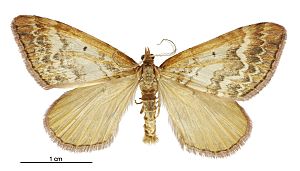Asaphodes helias facts for kids
Quick facts for kids Asaphodes helias |
|
|---|---|
 |
|
| Male | |
| Scientific classification | |
| Synonyms | |
|
The Asaphodes helias is a type of moth that belongs to the family Geometridae. This moth is special because it is endemic to New Zealand. This means it is found only in New Zealand and nowhere else in the world. People have seen this moth in areas like Canterbury, Otago, and Southland.
About This Moth
This moth was first described in 1883 by a scientist named Edward Meyrick. He found it in Dunedin, a city in New Zealand. At first, he called it Larentia helias.
Later, another scientist, George Hudson, studied and drew pictures of this moth. He called it Xanthorhoe helias in his books from 1898 and 1928.
In 1971, John S. Dugdale moved this moth into a different group, the Asaphodes genus. The very first specimen of this moth, called the type specimen, is kept safe at the Natural History Museum, London.
What It Looks Like
George Hudson described this moth in detail. Its wings spread out about 1 inch (2.5 cm) wide. All its wings are a pale yellowish-brown color.
The front wings have a thin brown line near the base. They also have a large loop-shaped mark from the top edge. This mark almost connects to a smaller loop from the bottom edge.
Beyond the middle of the wing, there's a wide, dark brown band. This band has an uneven shape. After that, there's a lighter band, then another narrow brown band. Near the tip of the wing, there's a small brown mark. Along the very edge of the wing, there are tiny black dots.
The back wings have several faint, dark lines near their base. They also have a row of small spots near the edge. Like the front wings, they have tiny black dots along the edge. The hairs along the edges of all the wings are a reddish-yellow color.
Where It Lives
This moth is found only in New Zealand. Besides Dunedin, where it was first discovered, it has been seen in other places. These include the Dansey Ecological district and the Nevis Red Tussock Fen in Otago. It has also been found near the Hooker traffic bridge, which is close to Mount Franklin in Canterbury.
Life Cycle
You can usually spot the A. helias moth flying around in January and February.
Home and Food
This moth likes to live in areas with tussock grasses and scrubby plants. It is often found where the fern Polystichum vestitum grows.
Scientists have raised the caterpillars of A. helias in labs. They found that the caterpillars eat forest plants like Cardamine and Ranunculus species. These caterpillars also eat these plants in the wild. Interestingly, they have also learned to eat a type of buttercup that is not native to New Zealand.
Images for kids


